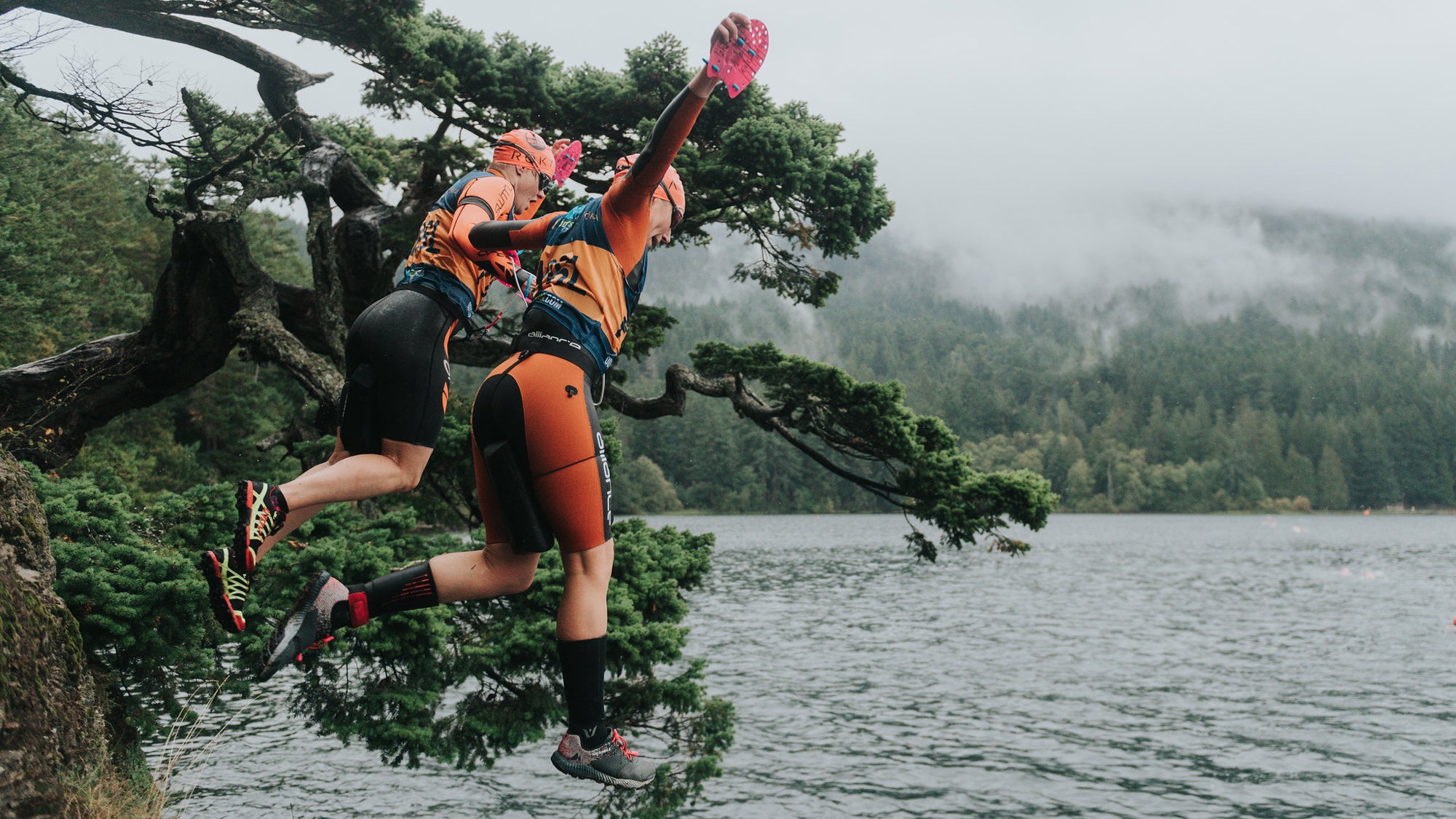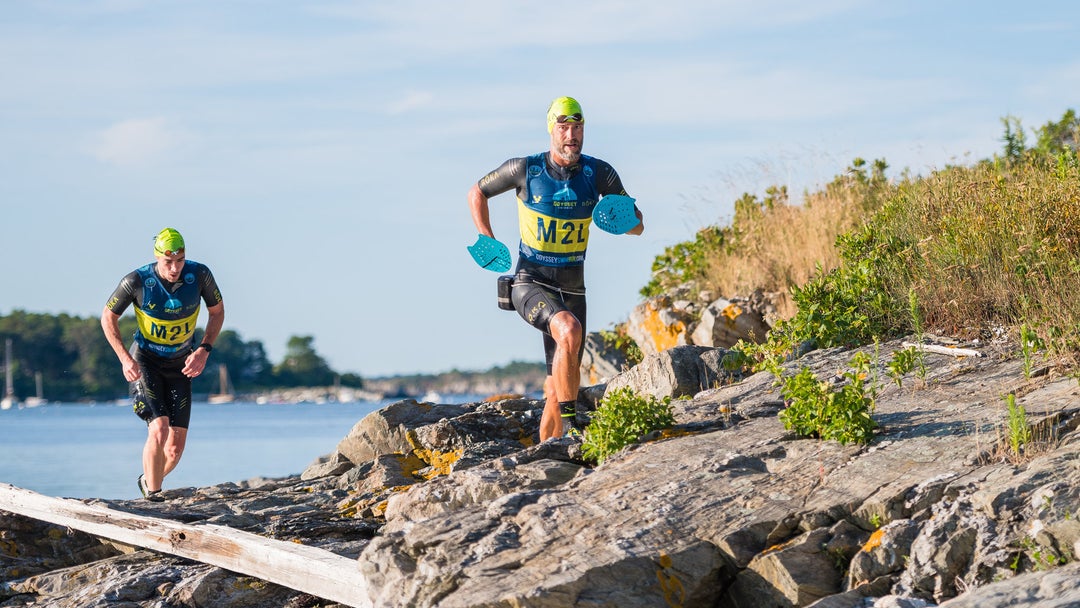Everything to Know Before Attempting a Swimrun

Photo: Odyssey Swimruns
Though the first swimrun event—in the form we now recognize it—may have taken place over a decade ago, 2020 will mark the turning point for the low-tech-multisport-turned-adventure-racing style of competition in the U.S. With the arrival of Otillö’s first world series event on March 1 off the coast of Los Angeles on Catalina Island, the European phenomenon has officially landed in North America. We quickly take a look at the basics of swimrun and give some swimrun tips from two veteran racers competing in this weekend’s inaugural event.
What Is Swimrun?
Started in Sweden back in 2002 as what most would consider an endurance-laced bar bet, today’s version usually has two teammates swimming and running together over multiple legs and multiple distances. The sport is even younger in the U.S., as the first swimrun event in this vein was the Casco Bay Swimrun in Portland, Maine, in 2015. Unlike triathlon, there are no equipment changes, no transition zones, just (roughly) set distances of open-water swimming and usually trail running. Some legs of the run could be very short—like a few hundred meters over a rocky outcropping—or more like 10 miles; same goes for the swims. Think a little more like adventure racing—minus the skill set and expense of lots of equipment—or XTERRA, and less like a slick and polished Ironman event. For “full” events, expect to be racing for anywhere from six to 10 hours, but shorter events can be much less.
Because there are no transition areas and varying lengths of legs, participants carry their own gear—which includes swim paddles, a pull buoy, and an optional tether to help pull your teammate along. Swimrun even has its own specialized gear, and triathlon companies are starting to take notice with swimrun wetsuits and other offerings. Check out our full guide on how to get started in swimrun for more.
Related Links:
Hold My Bike: A Look at the Rapid Growth of Swimrun
Swimrun: Your Ticket to a Faster Tri
Video Review: New Roka Maverick Swimrun Wetsuit
Nearly 400 Compete at 2019 Odyssey SwimRun Casco Bay Islands
Veteran Swimrun Tips from Annie Molsberry
36 – Bellingham, WA

Annie Molsberry has competed in eight swimrun events of varying distances since 2017. A self-proclaimed endurance “jack of all trades and master of none,” Molsberry has a strong running background, but primarily competed in adventure racing before finding swimrun. As opposed to adventure events that can range from 24 to 128 hours of continuous racing, she says she loves the fact that she “can finish before the sun goes down and enjoy a good meal and night of sleep after the effort.”
Get Along
When she first began swimrunning, Molsberry was taken aback by the sense of camaraderie—something that can often be missing in “bigtime” events. “I think the element of competing with a partner for the entire race distance really opens people up to a broader experience,” she says. “You can’t just put your head down and hammer in a swimrun.”
Because unpredictable terrain is a simple fact of life for swimrun, it can feel more like “everyone versus the course,” rather than a focus on time, PRs, and distance. “The sense of sharing something challenging, new, and completely awesome with the other racers out there has been present at every swimrun event I have completed.”
Get A Partner
The one piece of equipment Molsberry says she couldn’t live without? Her teammate. “The most important thing every first-time swimrunner should be sure they have is a partner,” she says emphatically. “Many swimrun events offer the option to race solo in order to reduce barriers to entry or appeal to folks used to solo racing. In my opinion, the partner element is the crux of what makes swimrun so awesome, and you’re only cheating yourself out of optimizing your experience if you decide to go it alone.”
Go Low (Tech)
When you go swimrun, you can leave the techy gear behind, but there are still a few items you can’t live without: Races like Otillö require some sort of wrappable bandage (rough rocks can equal big cuts), a safety whistle, and sometimes even a wetsuit depending on the water temperature. Paddles, a tether, your cap, and your goggles all also need a place to live while you run, so some DIY MacGuyver-like ingenuity is a swimrun requirement. Another essential piece of equipment that triathletes would be surprised to hear about is something we usually leave in our swim bags on race day. “Get a pull buoy with an attachment bungee fit either for your thigh or your waist,” Molsberry says. “This allows you to save your legs for running and floats your hips during the swims to minimize drag from your running shoes.”
After that, Molsberry recommends a wetsuit as many swimrun events take place in cold bodies of water. Also, one little piece of equipment no triathlete should ever be without: “Investing in some good anti-chafe lube is worth the five dollars to make sure your wetsuit doesn’t eat you alive when you try to run in it.”
Know The Course (And Appreciate It!)
If you can’t do the course—or even sections of it—be sure you know the distances of the legs, and mark them down somewhere. A swimrun tradition has racers write each swim or run distance around the outside of their paddles. As each course varies wildly, be sure to do as much research as you can. “The (Otillö Catalina) World Series course looks like some straightforward and long swim sections with no big crossings or serious currents to navigate, and some steep climbs (especially in the first half of the course) that gain elevation quickly,” she’s gathered. “My crystal ball is showing me lots of speed hiking on those climbs. I go back and forth about whether the Catalina course is a swimmer’s race or a runner’s race, but I think I’m leaning slightly to it being a swimmer’s race due to the number of long swims over 1000 meters.”
Unlike in a tri, however, be prepared to take in the unique sights on course that you’ll be afforded by venturing into places bikes or vehicles could never go. ”The expansive views, clear water, and biodiversity of fish and sea life (in Catalina) is something that will really make this course special,” Molsberry says.
Molsberry’s Favorite Swimrun Workout
Molsberry likes swim and run bricks built around the amount of time and terrain she has available. “They can also be done indoors if necessary using a pool and treadmill for a true training-spectacle at the gym,” she adds.
Her favorite one-hour workout takes place at a local lake/trail system and emphasizes quick transitions (essential in swimrun) and increasing her pace over the course of the session:
Run: 1 mile
Swim: 250 m
Run: 1.3 miles
Swim: 200 m
Run: 0.5 mile
Swim: 200 m
Run: 0.5 mile
Swim: 450 m
Total Run: 5K
Total Swim: 1100m
Veteran Swimrun Tips from John Stevens
40 – Portland, OR

John Stevens’s background was actually in swimrun before swimrun was even a thing. He grew up in the island area of Portland, Maine, before swimming at the University of Miami. After taking up running (with injuries that followed), Stevens turned to triathlon to satisfy his love for running and swimming. He eventually found his way to swimrun and has five Odyssey Swimrun wins under his belt alongside an Otillö World Championship finish.
It’s Not Tri
Despite Steven’s background in triathlon, he found a permanent home in swimrun because it has so many things that tri does not. “The team aspect and camaraderie of swimrun got me hooked,” he says. “Racing with a friend and other like-minded people who are out there for an adventure, not a PR. Time is irrelevant in swimrun except to tell you how far apart racers finished. There is no set distance and no standard course, it’s always different. It’s always an adventure and an experience over a race.”
It’s Tough
When Stevens finally made his way to swimrun, he was shocked by how uniquely tiring it was. “The type of fatigue you feel going between running and swimming so many times is very different than anything you get with triathlon or just running or swimming,” Stevens says. “As you progress, your legs start cramping on the swims but then you need to run. Then your lats and triceps cramp on the run but then you need to swim. With the constant and numerous transitions, it’s a difficult feeling to nail down and it wears on you as the race goes on, this is something I was not prepared for early on.”
Tether Together
Swimrun rules allow teammates to tether to each other via nylon webbing or a bungee. While not required (or even recommended) at all times, the tether can provide a huge advantage when one partner is struggling. “Most racers will have a race belt to attach the tether,” Stevens says. “A good tether should be long enough so you are not forced right onto the feet of the leading swimmer but not so long that you get dropped off the back and out of the draft zone. Something with some stretch to it is ideal, like a bungee cord and each athlete should have a way to attach it to themselves.”
Paddles Matter
Another piece of tri-forbidden equipment that Stevens says is incredibly important for swimrun is a pair of paddles. “With swimrun, you are swimming in your running shoes, which creates a good amount of drag and slows you down considerably,” he says. “Also, swimrun-specific wetsuits tend to be much thinner from the waist down to make running easier, but with that, you lose a good amount of buoyancy. The pull buoy helps compensate for the loss of buoyancy, keep the shoes closer to the surface (less drag), as well as aid in body position. The paddles allow the swimmer to apply more force to their pull to counteract the drag from the shoes.”
Know The Course (It Might Suck)
As someone with tons of experience racing swimrun, Stevens still takes time to learn about the course. For this weekend’s inaugural Otillö Catalina, there’s not much of a reference point, except for the hills. “My first impression when looking at the maps and remembering the time I’ve spent at Two Harbors (on Catalina Island), is that this course is going to suck but in that masochistic kind of way,” he says. “There seems to be a ton of climbing, which will likely involve some power hiking in the race.”
Just like much of the swimrun experience, even the course itself will be an adventure that’s nearly impossible to properly prepare for; you just have to get out there and do it. “It’s relatively flat where I am in Maine and the elevation gain on this course is almost unfathomable. I think this is going to be the hardest part for me, and I’m sure others. Unless you live in an area where you can get in that kind of climbing and descending, it’s going to be a pretty big shock to the system come race day.”